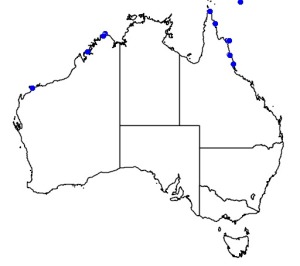
©Andy Lewis: A Pinkspot Shrimpgoby at the entrance to its burrow, with the host shrimp excavating sediment

©Anne Hoggett: Cryptocentrus leptocephalus at entrance of burrow with shrimp Alpheus sp. 1, among mangrove roots at Mangrove Beach, Lizard Island.
Colours
Distinguishing features
A small, elongate greyish white fish with a series of dark vertical bars on the flanks, and bright pink and blue spots on the head and upper back. Usually seen at the entrance to the burrow it shares with an Alpheid shrimp.
Size
- Up to 10 cm (Standard length)
Depth range
- Depth range data is not yet available.
Synonyms
Distribution
Distribution and habitat preferences
Areas of rubble and sediment in shallow locations. A good population of this species can be found amongst the mangrove roots at the eastern end of Mangrove beach.
Found in sheltered habitats.
Behaviour
The Pinkspot Shrimpgoby is one of many goby species that have a mutualistic relationship with Alpheid shrimps. The shrimp helps mainatain the burrow and guards the goby's eggs, while the goby stands guard at the entrance, watching for predators and feeding on plankton and detritus. The shrimp keeps one of its antennae in constant contact with the goby, and the two communicate with a series of tactile signals. Gobies are fast growing fishes and most do not live for more than 1 year.
Web resources
References
- Depczynski, M. and D.R. Bellwood (2003). The role of cryptobenthic reef fishes in coral reef trophodynamics, Marine Ecology Progress Series, 256: 183-191. LIRS catalog number 90050.
- Hernaman, V. and P.L. Munday (2005). Life-history characteristics of coral reef gobies. I. Growth and life-span, Marine Ecology Progress Series, 290: 207-221. LIRS catalog number 90051.
- Hernaman, V. and P.L. Munday (2005). Life-history characteristics of coral reef gobies. II. Mortality rate, mating system and timing of maturation, Marine Ecology Progress Series, 290: 223-237. LIRS catalog number 90052.
